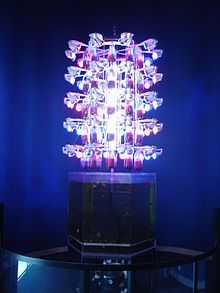Ken Rinaldo
| Ken Rinaldo | |
|---|---|
| Born | 1958 |
| Website | |
|
kenrinaldo | |
Ken Rinaldo (born 1958) is an American artist and educator internationally recognized for his interactive robotics and bio-art installations. He creates interactive art installations that explore the intersection between nature and technology. His robotic and bio-art installations seek to merge the organic and electromechanical seamlessly through sonification, interactivity and motion, expressing a gentle symbiosis.
His works are influenced by living systems theories, interspecies communication, artificial life research, and the idea of emergent properties. His work also deals with ecological issues often overlooked in favor of technological progress.
Ken Rinaldo's best known works are Autopoiesis (2000), an a-life robotic installation exploring the idea of group consciousness [1][2][3] and Augmented Fish Reality (2004), a fish-driven robot.[4]
Biography
He has an Associates in Science in Computer Science from Cañada College, 1982; a Bachelors of Art in Communications from The University of California, Santa Barbara; 1984 and a Masters in Fine Arts in Conceptual and Information Arts from San Francisco State University, 1996.

In 2000 he received the first prize at the VIDA 3.0 International Artificial Life Competition for Autopoiesis , in 2001 the same piece received an honorable mention at the Ars Electronica Festival. In 2004. Ken Rinaldo's art piece Augmented Fish Reality was awarded with an award of distinction at the same festival .
Rinaldo directs the Art & Technology program in the Department of Art at the main campus of the Ohio State University. He teaches interactive robotic sculpture, 3D modeling, rapid prototyping, motion graphics and animation.
Philosophy
Rinaldo is concerned with an idealized melding or an intersection that he believes is possible between natural and technological systems. He often asserts that integration of the natural and non-organic electro-mechanical elements are part of an important and very natural confluence and co-evolution that is necessary between living and our evolving technological material. His art works are influenced and evolve with research into living systems theory, artificial life and the current technologies we use to model and express mimesis through our current understanding of natural living systems.[5]
References
- ↑ Artificial Life 7 Workshop Proceedings, Carlo C. Maley and Eilis Boudreau Editors, Autopoiesis by Kenneth E. Rinaldo pgs, 166-169
- ↑ Information Arts, Intersections of Art, Science, and Technology Stephen Wilson pgs 113-114, 341-342, 344, 427
- ↑ Digital Art by Christiane Paul ISBN 978-0-500-20367-5. pg 144, 145
- ↑ Kenneth Rinaldo and France Cadet: artificial life and the lives of the non-human. (Critical Essay): An article from: Parachute: Contemporary Art Magazine [HTML] (Digital) by Carol Gigliotti pgs 69-83
- ↑ Leonardo, Volume 31, number 5, 1998 Technology Recapitulates Phylogeny Artificial Life Art by Kenneth Rinaldo pgs 371-376